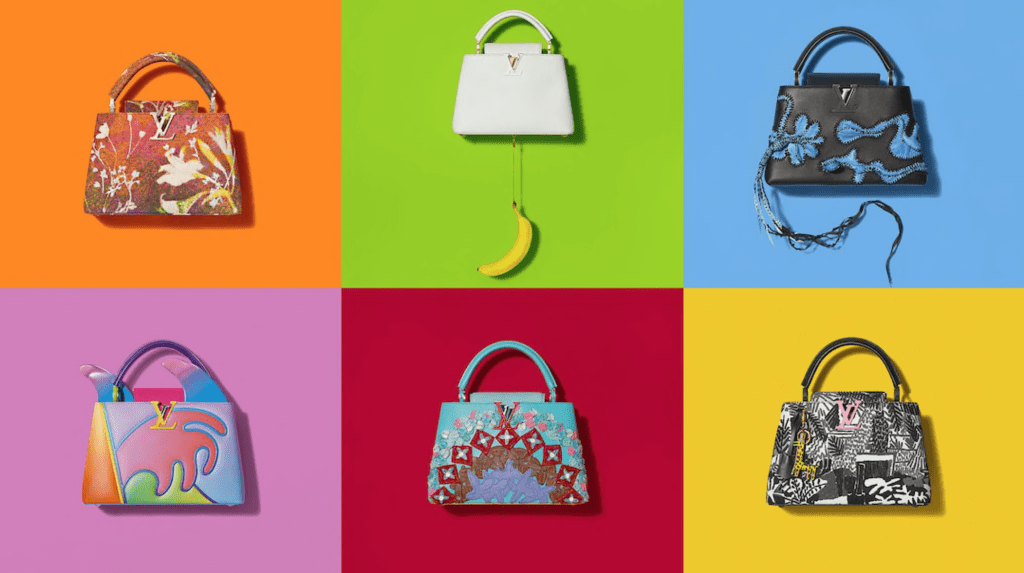Louis Vuitton reopened its refurbished flagship store in Florence in March 2019 to great fanfare from the fashion industry. The world’s largest luxury fashion brand made great play of the fact that, alongside all the apparel and accessories up for offer, the refurbished store – which is located in a famed Florentine palazzo –is replete with artworks, including those by Italian artists, such as Osvaldo Medici del Vascello and Massimo Listri. The brand has since looked to more modern artists, such as Alex Israel, Sam Falls, Urs Fischer, Nicholas Hlobo, Tschabalala Self and Jonas Wood, for a handbag collaboration.
The art world has a history of providing inspiration for designers out to produce new and/or timeless wares, and luxury fashion brands have long partnered with artists in much this same vein. As of 2019, it’s almost impossible to find a fashion house that is not using art to promote their brands – whether it is through window displays, advertisements, billboards, or in-store art exhibitions or by putting art on the catwalks and in the collections, themselves. Luxury fashion brands know that they need a point– or better yet, points – of differentiation if they want to enhance their images of exclusivity and charge higher prices for their products, and studies have suggested that an association with art allows commercial brands to be perceived as more luxurious.
With that in mind, luxury brands are moving directly in the art field, as demonstrated by the stream of art-centric collaborations that appear on runways each season and/or in their flagships across the globe. More than just using art for purely commercial purposes, they are also investing quite conspicuously in the cultural industry, as well. By way of foundations, as well as commission and residence platforms, brands like Salvatore Ferragamo, Trussardi, Hermes, and Ermenegildo Zegna, among others, are investing in art, and collecting valuable contemporary (sometimes modern) pieces. The likes of Prada and Louis Vuitton have gone one step further with their respective Fondazione Prada in Milan and Fondation Louis Vuitton in Paris, which may carry the names of fashion houses, but they are fully-fledged art galleries open to the public.
Prada’s private collection contains pieces by Jeff Koons and William N. Copley, to mention just two. The Miuccia Prada-led brand has also commissioned and produced pieces by artists, such as Anish Kapoor and Thomas Demand, while, pieces like “Nu bleu aux bas verts” by Henri Matisse and “Ladies and Gentlemen” by Andy Warhol are part of Fondation Louis Vuitton’s sweeping private collection, alongside “Inside the Horizon,” a site-specific work by Icelandic-Danish artist Olafur Eliasson on display at Fondation Louis Vuitton.
Not to be outdone, François Pinault, the majority shareholder and honorary chairman of the retail conglomerate Kering, has funded a nearly $170 million redevelopment of the Bourse de Commerce, the domed former commercial building located on Paris’ Rue de Viarmes, which – beginning in 2020 – will serve as the home for his personal collection of contemporary art. Consisting of about 5,000 works by artists, such as Jeff Koons, Cy Twombly, and Cindy Sherman, the collection’s impending new home will be “Paris’s second billionaire-funded art space after the Fondation Louis Vuitton, which was inaugurated in 2014 by Bernard Arnault, chairman and chief executive of the rival luxury-goods group LVMH Moët Hennessy Louis Vuitton,” the New York Times noted this spring.
Reflecting on the activity of some of luxury fashion’s most esteemed names, you could almost draw comparisons with the Medici family of renaissance Florence, a name that is among the most renowned art patrons in history and also a pioneering banking family and political dynasty. These luxury fashion houses and their shrewd leaders clearly understand the enormous power that art, and culture in general, can wield in a commercial and even political context.
All the while, it appears that many of these companies are moving their respective brand image from that of the ephemeral – producing merely seasonal clothing and accessories and interpreting style and trends – to a something altogether more permanent and important: that of cultural definers, something that could further bolster their bottom lines by association.
The question remains: are fashion’s art endeavors actually fulfilling any of art’s core functions? Art is a such a powerful tool for good. Art can help to create a sense of community, it can help lonely people find a purpose and a group to share their ideas with. Art can help teenagers understand what they are feeling. Art can be therapeutic for people with mental health problems and it can help people from diverse communities find common bonds. To what extent are these foundations actually doing this? And to what extent are they relying on art to bolster the value of their own names and thus, their products?
While these questions are very much up for debate, one thing is clear: they are using their commercial brand power to bring art to more people.
Alessia Grassi is a lecturer in marketing at the University of Huddersfield. Edits/additions courtesy of TFL













